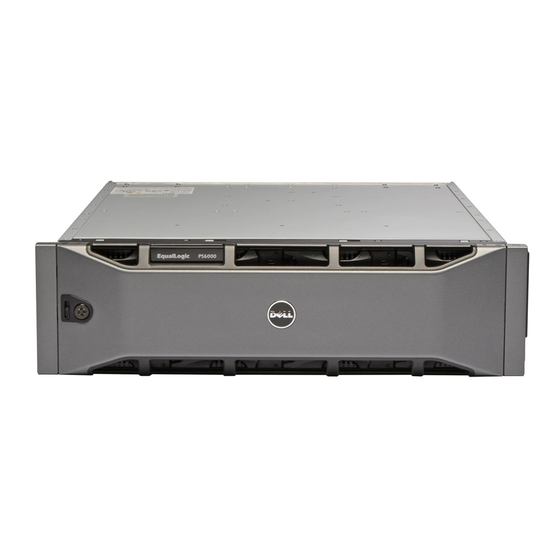Dell EqualLogic PS4110XV Посібник з експлуатації обладнання - Сторінка 5
Переглянути онлайн або завантажити pdf Посібник з експлуатації обладнання для Зберігання Dell EqualLogic PS4110XV. Dell EqualLogic PS4110XV 50 сторінок. Equallogic ps series iscsi storage arrays with microsoft windows server failover clusters

Introduction
A Dell Failover Cluster combines specific hardware and software components to provide enhanced availability for
applications and services that run on your cluster. A Failover Cluster reduces the possibility of any single point of failure
within the system that can cause the clustered applications or services to become unavailable. It is recommended that
you use redundant components like servers, storage power supplies, connections between the nodes and the storage
array(s), and connections to client systems or other servers in a multi-tier enterprise application architecture in your
cluster.
This document provides information and specific configuration tasks that enable you to configure your Failover Cluster
with Dell EqualLogic PS Series Internet Small Computer System Interface (iSCSI) storage array(s).
For more information on deploying your cluster with Microsoft Windows Server 2003 operating systems, see the
Failover Clusters with Microsoft Windows Server 2003 Installation and Troubleshooting Guide at support.dell.com/
manuals.
For more information on deploying your cluster with Windows Server 2008 operating systems, see the
Clusters with Microsoft Windows Server 2008 Installation and Troubleshooting Guide at support.dell.com/manuals.
For a list of supported operating systems, hardware components, and driver or firmware versions for your Failover
Dell Cluster Configuration Support Matrices at dell.com/ha.
Cluster, see the
Cluster Solution
Your cluster supports a minimum of two nodes to a maximum of either eight nodes (with Windows Server 2003 operating
systems) or sixteen nodes (with Windows Server 2008 operating systems) and provides the following features:
•
Gigabit and 10 Gigabit Ethernet iSCSI technologies
•
High availability of resources to network clients
•
Redundant paths to the shared storage
•
Failure recovery for applications and services
•
Flexible maintenance capabilities, allowing you to repair, maintain, or upgrade a node or storage array without
taking the entire cluster offline
The iSCSI protocol encapsulates iSCSI frames that include commands, data, and status into Transmission Control
Protocol/Internet Protocol (TCP/IP) packets to be transported over Ethernet networks. The iSCSI frames are sent
between the Microsoft iSCSI Initiator that resides in the host and the iSCSI target, which is a storage device.
Implementing iSCSI in a cluster provides the following advantages:
Geographic distribution Wider coverage of Ethernet technology allows cluster nodes and storage arrays to be
located in different sites.
Low cost for availability Redundant connections provide multiple data paths that are available through inexpensive
TCP/IP network components.
Connectivity
A single technology for connection of storage array(s), cluster nodes, and clients.
1
Dell
Dell Failover
5
